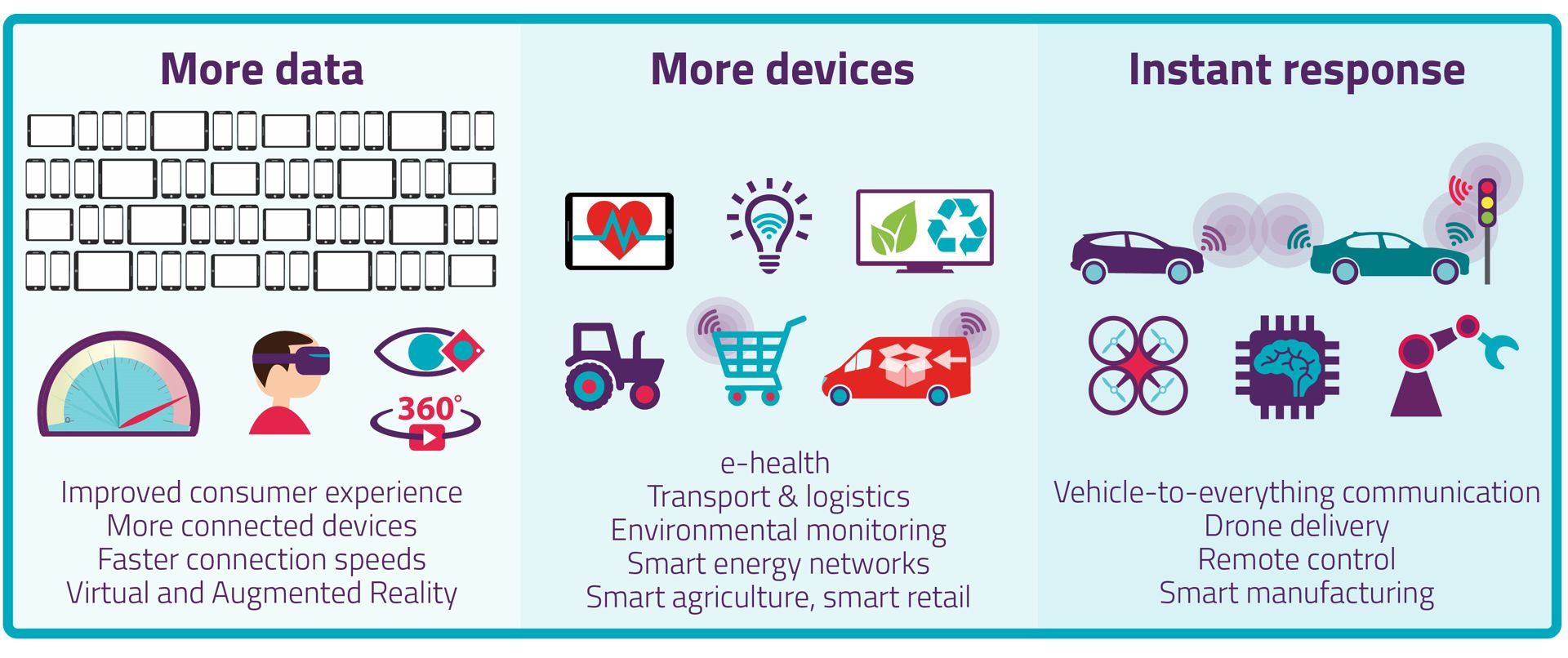5G is the new generation of wireless technology.
It follows previous generations of mobile technology such as 3G, which led to the launch of smartphones, and 4G, which enabled faster browsing, allowing us to do things like watching videos on the move.
All four major UK mobile networks have launched 5G services. Technology firms are also rolling out 5G-ready devices.
More data, more connected devices, instant response
For starters, 5G is much faster than previous generations of wireless technology. But it’s not just about speed. 5G also offers greater capacity, allowing thousands of devices in a small area to be connected at the same time.
The reduction in latency (the time between instructing a wireless device to perform an action and that action being completed) means 5G is also more responsive. This means gamers will see an end to the slight delays that can occur, when games can take time to reflect what they’re doing on their controller.
But the biggest differences go far beyond improving the way we use existing technology like smartphones or games consoles. The connectivity and capacity offered by 5G is opening up the potential for new, innovative services.

It can benefit people and businesses in many different ways
5G is already being used and tested across a number of sectors, benefiting people and businesses.
For example, one local council has installed 5G nodes on lamp posts to create a network aimed at helping social care patients. So far it has helped to keep patients and their families connected via virtual reality, as well as enabling biomonitors to detect whether patients are dehydrated. It is also being used to connect video systems that allow pharmacists to remotely check whether patients are taking their medication.
5G is also being used in farming – with one example being autonomous farming machinery. Machines scour the field using a video sensor, and apply fertilisers and pesticides where they’re needed. This helps to save resources and boost efficiency.
5G can also enable manufacturers to use smart machinery, providing and reacting to real-time data to improve efficiency.
Transport networks, local authorities and other public bodies could use it to improve public services like parking, traffic management and street lighting.
It could also bring major changes to healthcare. For example, by enabling technology that allows medical students to practise surgery in a connected, virtual reality environment that reflects a real-life experience – even allowing them to ‘feel’ the surgery they are training to deliver.
One mobile network is currently trialling ‘smart ambulances’ equipped with 5G technology, which will explore how will explore how patients could be treated in an emergency by connecting paramedics with hospital staff.
The connectivity offered by 5G also allows existing applications to be carried out more quickly and dependably.
It does not pose any health risks
In the UK, Public Health England (PHE) leads on health matters related to radiofrequency electromagnetic fields, or radio waves. It also has a duty to advise the Government on any health effects that may be caused by EMF emissions. On 5G, PHE’s view is that ‘the overall exposure is expected to remain low relative to guidelines and, as such, there should be no consequences for public health’.
We have measured the electromagnetic field emissions from equipment used to transmit mobile signals and other wireless services for a number of years. We have extended this measurement programme to cover the frequencies being used for 5G.
We measured 5G sites in various towns and cities across the UK, focusing on areas where mobile use is likely to be highest. At every site, emissions were a small fraction of the levels included in international guidelines, as set by the International Commission on Non-Ionizing Radiation Protection (ICNIRP).
Further information on exposure to electromagnetic fields is available.
Ofcom’s role in 5G
We’re working with the Government and industry to help the UK become a world leader in 5G.
We have released airwaves needed for 5G products to work, and have helped companies to test 5G services, to help get innovative new services off the ground.
We’re helping smaller businesses and start-ups by giving them access to the airwaves they need to set up their own local 5G networks. These airwaves are licensed to mobile companies, but aren’t being used by them.
We have also worked with the UK Government to produce a guide to 5G (PDF, 604.2 KB), which local authorities and other bodies can use when managing enquiries they receive.
What is spectrum?
You can’t see or feel radio spectrum. But any device that communicates wirelessly needs spectrum – such as televisions, car key fobs, baby monitors, wireless microphones and satellites. Mobile phones use spectrum to connect to a local mast so people can make calls and access the internet.
Why does Ofcom manage spectrum use?
Only a limited amount of spectrum is available, so it needs to be managed carefully. Certain bands of spectrum are also used for different purposes. For example, mobile companies use different parts of the spectrum to TV companies. So, it needs to be managed to prevent services interfering and causing disruption to people and businesses.
